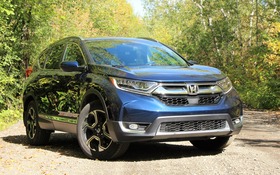2019 Honda CR-V: (Almost) a No-brainer

| Strong points |
|
|---|---|
| Weak points |
|
The compact SUV segment is killing the traditional automobile as consumers are trading in their sedans for these high-riding, versatile and—for the most part—all-wheel drive vehicles.
So far in 2019, the Honda CR-V is the second best-selling utility vehicle in Canada, ahead of the Nissan Rogue, the Ford Escape, the Hyundai Tucson and the Mazda CX-5, among others. Only the Toyota RAV4 is more popular right now.
- Also: Honda Cars, Plants Continue to Get Cleaner
- Also: 2020 Honda CR-V Gets Hybrid Treatment, Canada Won’t See it
Now in the third year of its current production cycle—the fifth generation—the CR-V relies on the usual, proven recipe that has made it so successful in our country. It’s surprisingly spacious for its size, and one of the roomiest in its class. Rear-seat occupants are treated to plenty of legroom, and the almost-flat floor means the middle passenger won’t be fighting for foot space.
Cargo space is rated at a segment-best 1,110 litres with the rear seats in place, and 2,146 litres with the seatbacks folded down. Only the Subaru Forester can do better in that area. In addition, the cargo cover can be conveniently stashed under the load floor. We fit five dining room chairs in the Honda, and there was room for a couple more.

As in the brand’s other products, the 2019 Honda CR-V’s interior design is conservative, but tasteful. A lot of effort is spent making sure the controls are ergonomically well laid out, like the wheel-mounted buttons that are all within our thumbs’ reach. There’s plenty of storage in the centre console to empty our pockets and keep refreshments at hand during our road trips.
However, there are climate control settings that can only be accessed on the seven-inch infotainment touchscreen, such as turning the A/C on and off and configuring the air vents. Why not just add a couple of buttons on the dash and bypass this extra step?
As for the infotainment system itself, well, it’s not the easiest to use in the industry, mainly because the on-screen button zones are too small. We can always just plug in our smartphone and use Apple CarPlay or Android Auto integration, which is standard across the board.
Except for the base LX-2WD trim level, all versions of the CR-V benefit from advanced safety features like adaptive cruise control, lane departure warning, lane keep assist, forward collision warning with autonomous emergency braking as well as automatic high beams. EX and EX-L trims get the Honda LaneWatch passenger-side blind spot display, but we prefer the regular blind spot monitoring system that works on both sides and includes rear cross traffic alert—which is only offered on the top-of-the-line Touring trim.
Since its redesign for the 2017 model year, the CR-V has been offered in Canada with a turbocharged engine and nothing else, while in the United States, a naturally aspirated, 2.4-litre four is available in the base trim. Also, the U.S. market will soon get a hybrid powertrain, but not us.
The 2.4-litre mill produces 184 horsepower and 180 pound-feet of torque, while the turbo engine develops 190 hp and 179 lb.-ft—but the latter is more fuel-efficient. Its city/highway ratings of 8.7/7.2 L/100 km with the all-wheel drivetrain are excellent, and aside from the Toyota RAV4 Hybrid that’s by far the fuel economy champ in its category, only the newly redesigned Ford Escape, the Forester and the non-hybrid RAV4 can come close to the Honda’s 8.0 L/100 km combined average. During our test, we ended up with a very good result of 8.3 L/100 km.

On the other hand, Honda’s 1.5-litre turbo engine has had some issues, both in the CR-V and the Honda Civic. Fuel was finding its way into the engine’s oil stream and the company had to provide an update to the vehicle software. Simply put, Honda stated it was a programming problem and not a mechanical one, affecting 2017 and 2018 model-year vehicles, but not the 2019 edition.
Still, we’re cautious about turbocharged engines and their potentially higher maintenance costs, and if we mentioned the 2.4-litre unit in the U.S.-spec CR-V, it’s because it might have been a better choice for long-term ownership. There are no turbocharged powertrains in the newly redesigned Toyota RAV4, it’s almost as efficient and will likely remain trouble-free for years to come.
We’re purely speculating about the reliability of the CR-V’s turbo mill, though, and maybe we won’t hear any more problems about it. One thing’s for sure: it doesn’t sound very good, especially when it isn’t fully warmed up. The important thing is that it doesn’t take up much fuel, and that’s good.
As for the 2019 Honda CR-V’s drive, we have nothing exciting or bad to report. It rides and handles like a compact SUV should, although there’s a little more suspension noise than we’d like.
Pricing starts at $27,690 before freight and delivery charges, although a CR-V with AWD will run at least $30,490. Standard features include dual-zone climate control, an intelligent key system with remote engine start and a height-adjustable driver’s seat and heated front seats. A power sunroof, power-adjustable seats, heated rear seats, navigation and perforated leather upholstery are all available, and our loaded Touring variant retails for $39,090. That price range is competitive, but we wish the heated steering wheel would be offered at a lower price point than in the $36K EX-L trim.
The 2019 Honda CR-V is comfortable, spacious, very fuel efficient and holds its value well. From a rational purchase standpoint, it should be a no-brainer, but the recent engine trouble means we’d recommend a RAV4 first and foremost. And if we’re looking for something with a little more excitement, we also have a soft spot for the Forester and the CX-5. Still, the CR-V remains one of the best compact SUVs out there, and its popularity is certain justified.











